Is New York City an Island or Peninsula?
New York City is a pulsating metropolis that harbors the great skyline, changing neighborhoods, and deep cultural heritage. However, one question always surfaces : is New York City an island or a peninsula? This would reflect the complicated geography of the city and its five boroughs - Manhattan, Brooklyn, Queens, Bronx, and Staten Island. Insights related to this geographical distinction can refer to developing an understanding of the unique character of the city.
The Anatomical Structure of New York City
To answer whether New York is an island or a peninsula, we must briefly describe its five boroughs:
Manhattan
This borough is actually an island, bounded by the Hudson River on its west side and the East River on its east side. It's the heart of New York, home to famous places such as Times Square and Central Park.
Brooklyn
People tend not to realize that Brooklyn is, in reality on the west end of Long Island. It goes as far north as the East River and ends south as the Atlantic Ocean. Even being surrounded by water on three sides, it is not classified as an island.
Queens
Just like Brooklyn, Queens is also on Long Island. It is bordered on the west by Brooklyn with waterfront along the East River and Flushing Bay.
The Bronx
On the mainland of New York State is Bronx separated by the Harlem River from Manhattan. Its boundaries do not include any islands.
Staten Island
Staten Island is, in itself, an island located southwest of Manhattan. It is accessible by ferry from Manhattan and joined with Brooklyn by the Verrazzano-Narrows Bridge.
The Geographical Complexity
New York City geography is confusing in part because its layout is a little unique. Manhattan and Staten Island are islands, but Brooklyn and Queens part of Long Island. This gives rise to some interesting discussion over how we consider what is an "island" versus a "peninsula."
Long Island
This is a long island extending eastward from New York City and also includes both Brooklyn and Queens, though it is not technically a peninsula, since it is too large because it extends on most sides into water.
Peninsulas of New York City
There are no real peninsulas within New York City. However, some areas do have a peninsula-like appearance. Some parts of Brooklyn stretch out into the waters surrounding it but do not qualify as a peninsula.
Historical Context
Once again, this historical context makes the distinctions based on these geographies add another layer to our understanding. The different areas were consolidated only in 1898 under one municipal government. This consolidation has in turn influenced the way the people of New York City envision their relationship with land and water.
Cultural Identity
Boroughs evolved the cultural identity overtime. For instance, to many people, Manhattan is perceived more as a cultural and financial hub, while Brooklyn is gradually recognized by its artistic communities, as well as trendy neighborhoods.
Economic Implications
The physical layout of New York City holds essential economic implications. The presence of water bodies makes the region suitable for trade and transport.
The proximity of this area to notable waterways makes New York an excellent point of trade. The Port of New York and New Jersey remains to date one of the busiest ports in the country.
Tourism
The uniqueness in geography attracts millions of tourists per year who come to explore either the iconic places in Manhattan or the hidden treasures in Brooklyn and Queens.
Conclusion
New York City makes for a pretty interesting case when discussing whether it is an island or a peninsula. Manhattan and Staten Island are clearly islands, while Brooklyn and Queens count as part of Long Island but are not considered to be themselves on that island. The Bronx resides on the mainland.
This complex geographic landscape has therefore enriched the cultural, economic, and identity tapestry of the city. As residents move about through this vibrant city, using any services like Sparkly Maid NYC or taking part in any of Queens's other diverse offerings, they remain in a place characterized by its peculiar geography.
This awareness allows us to know not only what is special about New York City but also in some sense how its geography has been factored into the evolution of the city.
